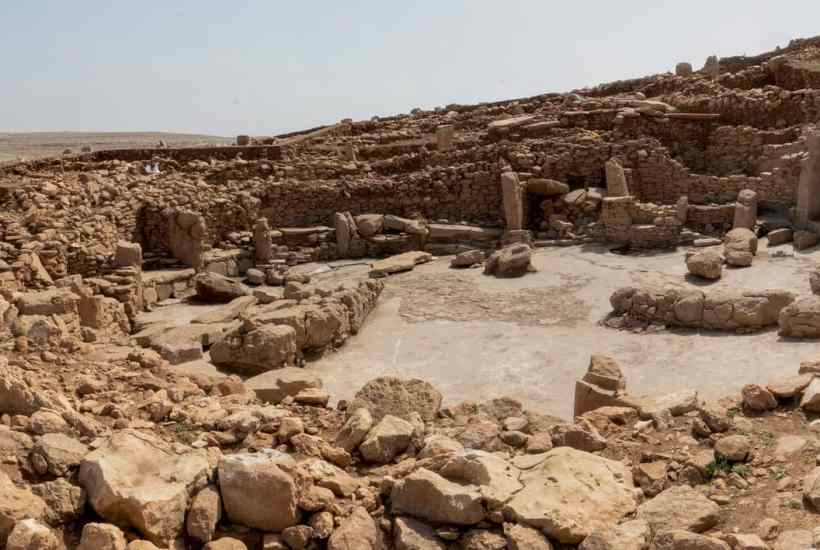I am staring at about a dozen, stiff, eight-foot high, orange-red penises, carved from living bedrock, and semi-enclosed in an open chamber. A strange carved head (of a man, a demon, a priest, a God?), also hewn from the living rock, gazes at the phallic totems – like a primitivist gargoyle. The expression of the stone head is doleful, to the point of grimacing, as if he, or she, or it, disapproves of all this: of everything being stripped naked under the heavens, and revealed to the world for the first time in 130 centuries.
Yes, 130 centuries. Because these penises, this peculiar chamber, this entire perplexing place, known as Karahan Tepe (pronounced Kah-rah-hann Tepp-ay), which is now emerging from the dusty Plains of Harran, in eastern Turkey, is astoundingly ancient. Put it another way: it is estimated to be 11-13,000 years old.
 The penis chamber (photo: iStock)
The penis chamber (photo: iStock)
This number is so large it is hard to take in. For comparison the Great Pyramid at Giza is 4,500 years old. Stonehenge is 5,000 years old. The Cairn de Barnenez tomb-complex in Brittany, perhaps the oldest standing structure in Europe, could be up to 7,000 years old.
The oldest megalithic ritual monument in the world (until the Turkish discoveries) was always thought to be Ggantija, in Malta. That’s maybe 5,500 years old. So Karahan Tepe, and its penis chamber, and everything that inexplicably surrounds the chamber – shrines, cells, altars, megaliths, audience halls et al – is vastly older than anything comparable, and plumbs quite unimaginable depths of time, back before agriculture, probably back before normal pottery, right back to a time when we once thought human ‘civilisation’ was simply impossible.
After all, hunter gatherers – cavemen with flint arrowheads – without regular supplies of grain, without the regular meat and milk of domesticated animals, do not build temple-towns with water systems.
Do they?
Virtually all that we can now see of Karahan Tepe has been skilfully unearthed the last two years, with remarkable ease (for reasons which we will come back to later). And although there is much more to summon from the grave, what it is already teaching us is mind stretching. Taken together with its age, complexity, sophistication, and its deep, resonant mysteriousness, and its many sister sites now being unearthed across the Harran Plains – collectively known as the Tas Tepeler, or the ‘stone hills’ – these carved, ochre-red rocks, so silent, brooding, and watchful in the hard whirring breezes of the semi-desert, constitute what might just be the greatest archaeological revelation in the history of humankind.
The unveiling of Karahan Tepe, and nearly all the Tas Tepeler, in the last two years, is not without precedent. As I take my urgent photos of the ominously louring head, Necmi Karul touches my shoulder, and gestures behind, across the sun-burnt and undulant plains.
Necmi, of Istanbul University, is the chief archaeologist in charge of all the local digs – all the Tas Tepeler. He has invited me here to see the latest findings in this region, because I was one of the first western journalists to come here many years ago and write about the origin of the Tas Tepeler. In fact, under the pen-name Tom Knox, I wrote an excitable thriller about the first of the ‘stone hills’ – a novel called The Genesis Secret, which was translated into quite a few languages – including Turkish. That site, which I visited 16 years back, was Gobekli Tepe.
Necmi points into the distance, now hazed with heat.
‘Sean. You see that valley, with the roads, and white buildings?’
I can maybe make out a white-ish dot, in one of the pale, greeny-yellow valleys, which stretch endlessly into the shimmering blur.
‘That,’ Necmi says, ‘Is Gobekli Tepe. 46 kilometres away. It has changed since since you were last here!’
And so, to Gobekli Tepe. The ‘hill of the navel’. Gobekli is pivotally important. Because Karahan Tepe, and the Tas Tepeler, and what they might mean today, cannot be understood without the primary context of Gobekli Tepe. And to comprehend that we must double back in time, at least a few decades.
The modern story of Gobekli Tepe begins in 1994, when a Kurdish shepherd followed his flock over the lonely, infertile hillsides, passing a single mulberry tree, which the locals regarded as ‘sacred’. The bells hanging on his sheep tinkled in the stillness. Then he spotted something. Crouching down, he brushed away the dust, and exposed a large, oblong stone. The man looked left and right: there were similar stone outcrops, peeping from the sands.
Calling his dog to heel, the shepherd informed someone of his finds when he got back to the village. Maybe the stones were important. He was not wrong. The solitary Kurdish man, on that summer’s day in 1994, had made an irreversibly profound discovery – which would eventually lead to the penis pillars of Karahan Tepe, and an archaeological anomaly which challenges, time and again, everything we know of human prehistory.
A few weeks after that encounter by the mulberry tree, news of the shepherd’s find reached museum curators in the ancient city of Sanliurfa, 13km south-west of the stones. They got in touch with the German Archaeological Institute in Istanbul. And in late 1994 the German archaeologist Klaus Schmidt came to the site of Gobekli Tepe to begin his slow, diligent excavations of its multiple, peculiar, enormous T-stones, which are generally arranged in circles – like the standing stones of Avebury or Stonehenge. Unlike European standing stones, however, the older Turkish megaliths are often intricately carved: with images of local fauna. Sometimes the stones depict cranes, boars, or wildfowl: creatures of the hunt. There are also plenty of leopards, foxes, and vultures. Occasionally these animals are depicted next to human heads.
Notably lacking were detailed human representations, except for a few coarse or eerie figurines, and the T-stones themselves, which seem to be stylised invocations of men, their arms ‘angled’ to protect the groin. The obsession with the penis is obvious – more so, now we have the benefit of hindsight provided by Karahan Tepe and the other sites. Very few representations of women have emerged from the Tas Tepeler so far; there is one obscene caricature of a woman perhaps giving birth. Whatever inspired these temple-towns it was a not a benign matriarchal culture. Quite the opposite, maybe.
The apparent date of Gobekli Tepe – first erected in 10,000 BC, if not earlier – caused a deal of skepticism. But over time archaeological experts began to accept the significance. Ian Hodden, of Stanford University, declared that: ‘Gobekli Tepe changes everything.’ David Lewis-Williams, the revered professor of archaeology at Witwatersrand University in Johannesburg, said, at the time: ‘Gobekli Tepe is the most important archaeological site in the world.’
And yet, in the nineties and early noughties Gobekli Tepe dodged the limelight of general, public attention. It’s hard to know why. Too remote? Too hard to pronounce? Too eccentric to fit with established theories of prehistory? Whatever the reason, when I flew out on a whim in 2006 (inspired by two brisk minutes of footage on a TV show), even the locals in the nearby big city, Sanliurfa, had no conception of what was out there, in the barrens.
I remember asking a cab driver, the day I arrived, to take me to Gobekli Tepe. He’d never heard of it. Not a clue. Today that feels like asking someone in Paris if they’ve heard of the Louvre and getting a Non. The driver had to consult several taxi-driving friends until one grasped where I wanted to go – ‘that German dig, out of town, by the Arab villages’ – and so the driver rattled me out of Sanliurfa and into the dust until we crested one final remote hill and came upon a scene out of the opening titles of the Exorcist: archaeologists toiling away, unnoticed by the world, but furiously intent on their world-changing revelations.
For an hour Klaus (who sadly died in 2014) generously escorted me around the site. I took photos of him and the stones and the workers, this was not a hassle as there were literally no other tourists. A couple of the photos I snatched, that hot afternoon, went on to become mildly iconic, such as my photo of the shepherd who found the site, or Klaus crouching next to one of the most finely-carved T-stones. They were prized simply because no one else had bothered to take them.

After the tour, Klaus and I retired from the heat to his tent, where, over dainty tulip glasses, of sweet black Turkish tea, Klaus explained the significance of the site.
As he put it, ‘Gobekli Tepe upends our view of human history. We always thought that agriculture came first, then civilisation: farming, pottery, social hierarchies. But here it is reversed, it seems the ritual centre came first, then when enough hunter gathering people collected to worship – or so I believe – they realised they had to feed people. Which means farming.’ He waved at the surrounding hills, ‘It is no coincidence that in these same hills in the Fertile Crescent men and women first domesticated the local wild einkorn grass, becoming wheat, and they also first domesticated pigs, cows and sheep. This is the place where Homo sapiens went from plucking the fruit from the tree, to toiling and sowing the ground.’
Klaus had cued me up. People were already speculating that – if you see the Garden of Eden mythos as an allegory of the Neolithic Revolution: i.e. our fall from the relative ease of hunter-gathering to the relative hardships of farming (and life did get harder when we first started farming, as we worked longer hours, and caught diseases from domesticated animals), then Gobekli Tepe and its environs is probably the place where this happened. Klaus Schmidt did not demur. He said to me, quite deliberately: ‘I believe Gobekli Tepe is a temple in Eden’. It’s a quote I reused, to some controversy, because people took Klaus literally. But he did not mean it literally. He meant it allegorically.
Klaus told me more astonishing things.
‘We have found no homes, no human remains. Where is everyone, did they gather for festivals, then disperse? As for their religion, I have no real idea, perhaps Gobekli Tepe was a place of excarnation, for exposing the bones of the dead to be consumed by vultures, so the bodies have all gone. But I do definitely know this: some time in 8000 BC the creators of Gobekli Tepe buried their great structures under tons of rubble. They entombed it. We can speculate why. Did they feel guilt? Did they need to propitiate an angry God? Or just want to hide it?’ Klaus was also fairly sure on one other thing. ‘Gobekli Tepe is unique.’
I left Gobekli Tepe as bewildered as I was excited. I wrote some articles, and then my thriller, and alongside me many other writers, academics and film makers made the sometimes dangerous pilgrimage to this sumptuously puzzling place near the troubled Turkey-Iraq border, and slowly its fame grew.
Back here and now, in 2022, Necmi, myself and Aslan Arwad – the director for Sanliurfa Culture and Tourism – jump in a car at Karahan Tepe (Necmi promises me we shall return) and we go see Gobekli Tepe as it is today.
Necmi is right: all is changed. These days Gobekli Tepe is not just a famous archaeological site, it is a Unesco World-Heritage-listed tourist honeypot which can generate a million visitors a year. It is all enclosed by a futuristic hi-tech steel-and-plastic marquee (no casual wandering around taking photos of the stones and workers). Where Klaus and I once sipped tea in a flapping tent, alone, there is now a big visitor centre – where I bump into the grandson of the shepherd who first found Gobekli. I spy the stone where I took the photo of a crouching Klaus, but I see it 20 metres away. That’s as close as I can get.
After lunch in Sanliurfa – with its Gobekli Tepe themed restaurants, and its Gobekli Tepe T-stone fridge-magnet souvenir shops – Necmi shows me the gleaming museum built to house the greatest finds from the region: including a 11,000 year old statue, retrieved from beneath the centre of Sanliurfa itself, and perhaps the world’s oldest life size carved human figure. I recall first seeing this poignant effigy under the stairs next to a fire extinguisher in Sanliurfa’s then titchy, neglected municipal museum. Back in 2006 I wrote about ‘Urfa man’ and how he should be vastly better known, not hidden away in some obscure room in a museum visited by three people a year.
Urfa man now has a silent hall of his own in one of Turkey’s greatest archaeological galleries. More importantly, we can now see that Urfa man has the same body stance of the T-shaped man-pillars at Gobekli (and in many of the Tas Tepeler): his arms are in front of him, protecting his penis. His obsidian eyes still stare wistfully at the observer, as lustrous as they were 11,000 years ago.
 (Photo: Sean Thomas)
(Photo: Sean Thomas)
As we stroll about the museum, Necmi points at more carvings, more leopards, vultures, penises. From several sites archaeologists have found statues of leopards apparently mounting, riding or even ‘raping’ humans, paws over the human eyes. Meanwhile, Aslan tells me how archaeologists at Gobekli have also, more recently, found tantalising evidence of alcohol: huge troughs with the chemical residue of fermentation, indicating mighty ritual feasts, maybe.
I sense we are getting closer to a momentous new interpretation of Gobekli Tepe and the Tas Tepeler. And it is very different from that perspective Klaus Schmidt gave me, in 2006 (and this is no criticism, of course: he could not have known what was to come).
Necmi – as good as promised – whisks me back to Karahan Tepe, and to some of the other Tas Tepeler, so we can jigsaw together this epochal puzzle. As we speed around the arid slopes he explains how scientists at Karahan Tepe, as well as Gobekli Tepe, have now found evidence of homes.
These places, the Tas Tepeler, were not isolated temples where hunter gatherers came, a few times a year, to worship at their standing stones, before returning to the plains for the life of the chase. The builders lived here. They ate their roasted game here. They slept here. And they used, it seems, a primitive but poetic form of pottery, shaped from polished stone. They possibly did elaborate manhood rituals in the Karahan Tepe penis chamber, which was probably half flooded with liquids. And maybe they celebrated afterwards with boozy feasts. Yet still we have no sign at all of contemporary agriculture; they were, it still appears, hunter gatherers, but of unnerving sophistication.
Another unnerving oddity is the curious number of carvings which show people with six fingers. Is this symbolic, or an actual deformity? Perhaps the mark of a strange tribe? Again, there are more questions than answers. Crucially, however, we do now have tentative hints as to the actual religion of these people.
In Gobekli Tepe several skulls have been recovered. They are deliberately defleshed, and carefully pierced with holes so they could – supposedly – be hung and displayed.
Skull cults are not unknown in ancient Anatolia. If there was such a cult in the Tas Tepeler it might explain the graven vultures pictured ‘playing’ with human heads. As to how the skulls were obtained, they might have come from conflict (though there is no evidence of this yet), it is quite possible the skulls were obtained via human sacrifice. At a nearby, slightly younger site, the Skull Building of Cayonu, we know of altars drenched with human blood, probably from gory sacrifice.

Necmi has one more point to make about Karahan Tepe, as we tour the penis chamber and its anterooms. Karahan Tepe is stupefyingly big. ‘So far,’ he says, ‘We have dug up maybe 1 per cent of the site’ – and it is already impressive. I ask him how many pillars – T stones – might be buried here. He casually points at a rectangular rock peering above the dry grass. ‘That’s probably another megalith right there, waiting to be excavated. I reckon there are probably thousands more of them, all around us. We are only at the beginning. And there could be dozens more Tas Tepeler we have not yet found, spread over hundreds of kilometres.’
In one respect Klaus Schmidt has been proved absolutely right. After he first proposed that Gobekli Tepe was deliberately buried with rubble – that is to say, bizarrely entombed by its own creators – a backlash of scepticism grew, with some suggesting that the apparent backfill was merely the result of thousands of years of random erosion, rain and rivers washing debris between the megaliths, gradually hiding them. Why should any religious society bury its own cathedrals, which must have taken decades to construct?
And yet, Karahan too was definitely and purposely buried. That is the reason Necmi and his team were able to unearth the penis pillars so quickly, all they had to do was scoop away the backfill, exposing the phallic pillars, sculpted from living rock.
I have one more question for Necmi, which has been increasingly nagging at me. Did the people that build the Tas Tepeler have writing? It is almost impossible to believe that you could construct such elaborate sites, in multiple places, over thousands of square kilometres, without careful, articulate plans, that is to say: without writing. You couldn’t sing, paint and dream your way to entire inhabited towns of shrines, vaults, water channels and cultic chambers.
Necmi shrugs. He does not know. One of the glories of the Tas Tepeler is that they are so old, no one knows. Your guess is literally as good as the expert’s. And yet a very good guess, right now, leads to the most remarkable answer of all, and it is this: archaeologists in southeastern Turkey are, at this moment, digging up a wild, grand, artistically coherent, implausibly strange, hitherto-unknown-to-us religious civilisation, which has been buried in Mesopotamia for ten thousand years. And it was all buried deliberately.
Jumping in the car, we head off to yet another of the Tas Tepeler, but then Necmi has an abrupt change of mind, as to our destination.
‘No, let’s go see Sayburc. It’s a little Arab village. A few months ago some of the farmers rang us and said “Er, we think we have megaliths in our farmyard walls. Do you want to have a look?”’
Our cars pull up in a scruffy village square, scattering sheep and hens. Sure enough, there are classic Gobekli/Karahan style T-stones, being used to buttress agricultural walls, they are probably 11-13,000 years old, just like everywhere else. There are so many of them I spot one of my own, on the outskirts of the village. I point it out to Necmi. He nods, and says ‘Yes, that’s probably another.’ But he wants to show me something else.
Pulling back a plastic curtain we step into a kind of stone barn. Along one wall there is a spectacular stone frieze, displaying animal and human figures, carved or in relief. There are leopards, of course, and also aurochs, etched in a Cubist way to make both menacing horns equally visible (you can see an identical representation of the auroch at Gobekli Tepe, so similar one might wonder if they were carved by the same artist).

At the centre of the frieze is a small figure, in bold relief. He is clutching his penis. Next to him, being threatened by the aurochs, is another human. He has six fingers. For a long while, we stare in silence at the carvings. I realise that, a few farmers apart, we are some of the first people to see this since the end of the Ice Age.
Got something to add? Join the discussion and comment below.
Get 10 issues for just $10
Subscribe to The Spectator Australia today for the next 10 magazine issues, plus full online access, for just $10.




















Comments
Don't miss out
Join the conversation with other Spectator Australia readers. Subscribe to leave a comment.
SUBSCRIBEAlready a subscriber? Log in